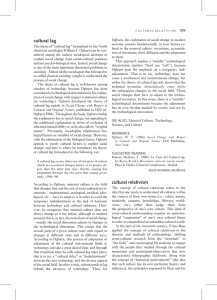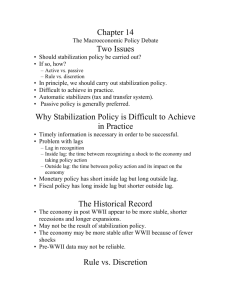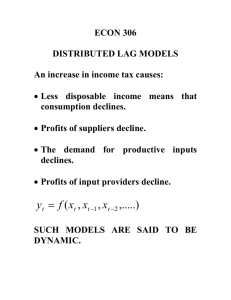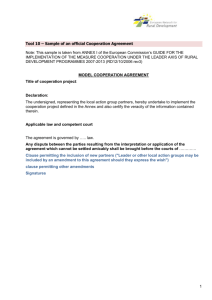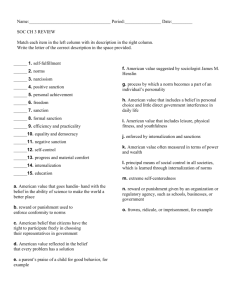Cultural Lag: Applying Time to Culture
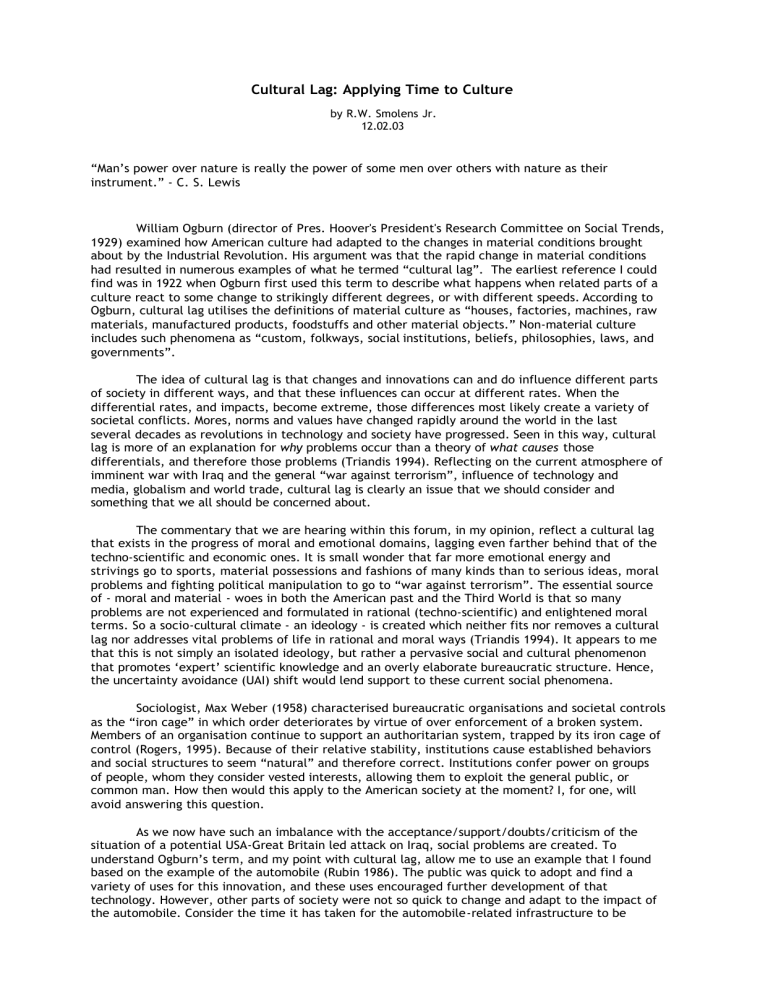
Cultural Lag: Applying Time to Culture
by R.W. Smolens Jr.
12.02.03
“Man’s power over nature is really the power of some men over others with nature as their instrument.” - C. S. Lewis
William Ogburn (director of Pres. Hoover's President's Research Committee on Social Trends,
1929) examined how American culture had adapted to the changes in material conditions brought about by the Industrial Revolution. His argument was that the rapid change in material conditions had resulted in numerous examples of what he termed “cultural lag”. The earliest reference I could find was in 1922 when Ogburn first used this term to describe what happens when related parts of a culture react to some change to strikingly different degrees, or with different speeds. According to
Ogburn, cultural lag utilises the definitions of material culture as “houses, factories, machines, raw materials, manufactured products, foodstuffs and other material objects.” Non-material culture includes such phenomena as “custom, folkways, social institutions, beliefs, philosophies, laws, and governments”.
The idea of cultural lag is that changes and innovations can and do influence different parts of society in different ways, and that these influences can occur at different rates. When the differential rates, and impacts, become extreme, those differences most likely create a variety of societal conflicts. Mores, norms and values have changed rapidly around the world in the last several decades as revolutions in technology and society have progressed. Seen in this way, cultural lag is more of an explanation for why problems occur than a theory of what causes those differentials, and therefore those problems (Triandis 1994). Reflecting on the current atmosphere of imminent war with Iraq and the general “war against terrorism”, influence of technology and media, globalism and world trade, cultural lag is clearly an issue that we should consider and something that we all should be concerned about.
The commentary that we are hearing within this forum, in my opinion, reflect a cultural lag that exists in the progress of moral and emotional domains, lagging even farther behind that of the techno-scientific and economic ones. It is small wonder that far more emotional energy and strivings go to sports, material possessions and fashions of many kinds than to serious ideas, moral problems and fighting political manipulation to go to “war against terrorism”. The essential source of - moral and material - woes in both the American past and the Third World is that so many problems are not experienced and formulated in rational (techno-scientific) and enlightened moral terms. So a socio-cultural climate - an ideology - is created which neither fits nor removes a cultural lag nor addresses vital problems of life in rational and moral ways (Triandis 1994). It appears to me that this is not simply an isolated ideology, but rather a pervasive social and cultural phenomenon that promotes ‘expert’ scientific knowledge and an overly elaborate bureaucratic structure. Hence, the uncertainty avoidance (UAI) shift would lend support to these current social phenomena.
Sociologist, Max Weber (1958) characterised bureaucratic organisations and societal controls as the “iron cage” in which order deteriorates by virtue of over enforcement of a broken system.
Members of an organisation continue to support an authoritarian system, trapped by its iron cage of control (Rogers, 1995). Because of their relative stability, institutions cause established behaviors and social structures to seem “natural” and therefore correct. Institutions confer power on groups of people, whom they consider vested interests, allowing them to exploit the general public, or common man. How then would this apply to the American society at the moment? I, for one, will avoid answering this question.
As we now have such an imbalance with the acceptance/support/doubts/criticism of the situation of a potential USA-Great Britain led attack on Iraq, social problems are created. To understand Ogburn’s term, and my point with cultural lag, allow me to use an example that I found based on the example of the automobile (Rubin 1986). The public was quick to adopt and find a variety of uses for this innovation, and these uses encouraged further development of that technology. However, other parts of society were not so quick to change and adapt to the impact of the automobile. Consider the time it has taken for the automobile-related infrastructure to be
built; around the world adequate infrastructure to support the uses desired by drivers still hasn't caught up to the demand created by the car.
Now applying Ogburn’s original description to our current situation with the perceptions of imminent war. Although striking political policy changes have occurred in the adaptive US culture when the Bush administration came to power, these changes perhaps do not synchronise exactly with the needs and realities of the current global/spiritual/human/conscientious culture. Rather, I would say, there is a culture lag that may last for some length of time, perhaps indeed, for many years. During this current era of maladjustment, I hasten to add that in the old adaptive culture
[protectionist, morally-superior, Anglo-centred, capitalism as a God] is hanging around even after the clear necessity or conditions have drastically changed, that even though it is being modified some as time goes on these changes will never be sufficient to meet the current political, cultural and religious conditions or stop the rising criticisms of certain political/economic strategies and policies.
Moreover, we are still in a process of adaptation to nuclear weapons, a process that is more than fifty years old. But an old adaptive culture pre-atomic thinking - still hangs on. I recall reading from many of the scientists from the Manhattan Project foretold of the necessary cultural adaptation that nuclear weapons were going to require. However, as I look back in my short life, their efforts were at best half-measures. We have been able to avoid any catastrophes, but we are now more than ever at a dangerous point because the current “war against terrorism” throws all hopes of deterrence, and the urgent need for cultural adjustment to nuclear weapons, out the window (Rubin1986).
Although the US administration may have us believe that they are going to save everyone from terrorism, the deterrence of war has brought about only a slight modification in the old US adaptive culture. It consequently is even more inadequate in helping the world to deal with the fundamentally new conditions that “terrorists”, weapons of mass destruction (WMD) and nuclear weapons bring to our doors and, it can be argued, the current US administration has now created an even larger obstacle to our natural cultural adjustment. As this administration continues to treat terrorists, WMD and nuclear weapons like pistols and rifles, albeit “safely under control of one government” or locked up in a cupboard, they are not afraid threaten to use any of these same tools if any one steps on the American front porch.
Traditional deterrence will not stop a disgruntled group with any identifiable address from striking out at America, or anywhere else for that matter, the attacks on the USS Cole and the
World Trade Center are profound examples. The deeper lesson from groups such as Japan’s Aum
Shinrikyo and the El Qaida is that “weapons-centred projects take on an illusion of sanity” even in the hands of so-called‚ ‘stable’ leaders such as Pres. Bush when in fact it is merely a deep illusion.
We need a worldwide awakening of moral indignation pushing the governments and their military establishments to get rid of these policies and weapons that in the long run endanger everybody and protect nobody.
Ogburn's cultural lag theory seems to revolve around a body of thought recognising individuals as member residents of respective cultures policed by social rules, folkways and customs, mores, and laws (Heyduk 1984). Correspondingly, each society would then bear obligations for managing its own technology and system, although an increasingly mobile and international mass media influences make this increasingly difficult. Time variables between social and technical advancements and adjustment to these influences represent cultural lag. The differential between the introduction and socially accepted diffusion phase can take many years, during which it may appear the transitional society is corrupt or failing, e.g. Russia shortly after the shift to democracy vis-à-vis capitalism.
Just consider the impact of the Internet on the various regions around the world. Here, the supporting infrastructure has clearly not been able to keep up with the innovation's adoption by others. Mobile phone technology examples, auditing/financial management examples, diversity management programme examples and virtual team implementation examples are just a few more to bring to this discussion. These various systems or organisations which are designed to control information, people, money and communications have not always kept pace with the progress of various technologies, ideologies, socio-economic realities, etc. create problems for those who exercise control.
2
Cultural lag is particularly a problem for technology/media, politics-world affairs, globalisation and international business for two reasons. First, the essential impact of those previously mentioned issues is that the speed in our lives has significantly increased over the past two decades. Second, there is very little that international business does not affect, or that could be drastically done in other ways. The Internet/media often brings communication at the speed of light; technology has affected our communication patterns, and the impact on communication, faster. That is the inherent nature of technology and the structure of the Internet/media: it works much faster than previous systems, and thus is much more likely to result in differences in the amount of time it takes to react to changes and innovations.
That mass media reach not only our homes but our minds is nothing new: Gutenberg's printing press in the early 1450's is the origin of mass communication, becoming Western culture's first practical method of disseminating ideas and information from a single source to a large and far-ranging audience. However, we should not forget that the invention of the printing press depended on a confluence of both cultural and technological forces that had been unfolding for several centuries; printing culture and technology also needed to go through centuries of change after Gutenberg's time before the massing of audiences could fully be realised.
If one considers that the impact of Internet/media/mobile technology has more to do with its content than the channel, and we accept that much of the content has cultural implications, and hence the brunt of impact and change is in the domain of culture (Bates 1992). I would contend that cultural change is an inherently slow process - large changes generally only occur between generations, as the young go through the socialisation process. Here one can imagine the high or low context societies, when in contact with one another, experiencing cultural lag. In addition, there are countervailing forces at work trying to minimise cultural changes. Therefore, while the essence of today’s communications is speed, the manner in which cultural changes, at least, are wrought by the Internet/mass media/mobile technology is limited to a much slower pace - to the speed at which we grow and learn, and acquire our culture.
Thus, the presence of cultural lag would seem to be inherent in even the natural evolution of political changes, and the continued development of, and use of, established political systems. It is therefore, even a greater potential problem when changes, innovations, and development are encouraged and guided by an aberrant policy (Schneider 1976). The goal of policy, after all, is to further speed some change (in the current case – attack Iraq) to achieve some desired state within some specific community at an earlier time than might otherwise naturally (or not at all) occur.
This then seems to only heighten the intrinsic speed differentials. Thus, even political policies are inherently susceptible to the creation of cultural lag.
My suppositions should not be taken to suggest that political policies undertaken to correct some “problem” always results in the creation of other problems. Although in our recent time that does seem to happen more with the current US administration, it need not always do so. Based on
Bates (1992) suggestions, I correlate his work to our current times and suggest, though, is that the
“military-hawks”/pro-anti terrorists/politicians/interculturalists/businesspersons must go beyond the simple question of “will XXX military-economic-immigration-diversity, etc. policy achieve this specific end?“ and begin to consider what other consequences our policies might have. Looking beyond the obvious is not always easy, it is tricky but politicians/managers/diplomats should begin looking at the potential for secondary and unintended effects. Should we not consider the potential for cultural lags, and whether there is anything in our ways that might encourage differential rates of adoption of change? To avoid cultural lag, our economic and political policies must begin to consider whether there are other ways in which society might be impacted, in different ways and at different rates.
In particular, those in power would do well to consider whether their policies would aggravate even more problems of cultural lag through the creation of impact differentials by their policies. For example, if differential treatment, in this case – war, is forced on Iraq, this will set up differential rates of impact, and the potential for cultural lag with the Palestinian-Israeli situation, the cooperation between the ‘traditional’ economic triads (N.America-EU/Middle East/Africa-Asia; based on M.Porter’s theories). A simpler case to understand would arise from differentials in the abilities of rich and poor to gain benefits from education. Such educational differentials certainly
3
create other social problems unanticipated by all of us sitting in our various corners around the world.
Cultural lag causes confusion and confusion causes us to grasp for any tool or idea that might help us make sense of our situation (Busch & Busch 1990). Hence, my previous posts to this group about those who use any ol’ definition of culture, as they deem appropriate. They refer to the most easily grasped are “magic bullets” because they are compatible with much of our postmodern industrial thinking about looking for a single cause. These magic bullets are also compatible with even more simplistic thinking of the pre-industrial era where logic was not even a requirement in a magical worldview where like goes with like. I would contend this lends support to the argument that the use of magic bullets makes us a danger to each other and to ourselves.
“I am not the same, having seen the moon shine on the other side of the world.”
- Maryanne Radmacher-Hershey
The potential for cultural lag, and the accompanying potential for the rise of social problems, as a result of technical innovation, political struggles, war and sustained development, is all too great. Therefore, all of us, our politicians (in every country, not only the USA), must not only be made aware of this potential, but they must begin to take it into consideration in our future planning. Might we, those of us here in this II-ers group shouting for change, be better off to look beyond the immediate, whether that be the immediate tragedies or benefits, the immediate time, or the focussed area, and consider the wider potential for change that any of their imagined changes would bring? I think that we can agree that not all cultural impacts are instantaneous, and that not all effects are obvious. I wholeheartedly support those who wish to give greater consideration to the other effects of the state of affairs these days. It is the only way in which we might be able to come to terms with our current global cultural lag.
R.W. Smolens Jr.
Aalen, 12 February 2003
4
References
Bates, B.J. Telecommunication Policy and Cultural Lag. Hong Kong Economic Journal. Vol. 22, No. 1
(1992).
Busch, J., & Busch, G. (1990). Sociological Theory: Derivations from sociocybernetics and negotiated organization. http://athena.louisville.edu/~jabusc01/theory.html
Heyduk, R. (1984). Thought and action as determinants of media- exposure. In J. Bryant & D.
Zillmann (Eds.), (pp. 113-140). Selective exposure to communication. Hillsdale, NJ: Lawrence
Erlbaum Associates.
Rogers, E. (1995). Diffusion of Innovations, (4th ed.). New York: The Free Press.
Rubin, A. (1986). Uses and gratifications and media effects research. In J. Bryant and D. Zillmann
(Eds.), Selective exposure to communication. Hillsdale, NJ: Lawrence Erlbaum Associates.
Schneider, L. (1976). Classical Theories of Social Change. Morristown, NJ: General Learning Press.
Triandis, H.C. (1994) Culture and Social Behavior. (pp.13-22). New York, NY: McGraw-Hill, Inc.
Additional Reading
Bannister, R.C. (1988) The case of William F. Ogburn. Paper presented at the annual meeting of the
American Sociological Society. http://www.swarthmore.edu/SocSci/rbannis1/Sociology/Ogburn/ogburn.ASS.html
Brinkman, R.L. and Brinkman, J.E. Cultural lag: concept and theory. International Journal of Social
Economics Vol. 24, No. 4 (1997).
Collective Behavior and Social Change http://www.nipissingu.ca/faculty/stanl/lecture19-2001.htm
Cultural lag: Reading Assignments. http://global.cscc.edu/ssci/101/Assignments/culturalLag.htm
Franke, B. and Rao, S.(1988) Ogburn's Cultural Lag theory: Revisiting the media-youth-violence triangle. http://tnet1.com/ogburn.htm
Schaeffer, R.T. Sociology Eighth Ed.[Online Study Guide-Resources] New York, NY: McGraw-Hill, Inc. http://tinyurl.com/5poo
Wright, R. (2000). Will Globalization Make You Happy?(Psychological and Social Effects of
Globalization). Foreign Policy. http://www.findarticles.com/cf_0/m1181/2000_Sept/67886150/p1/article.jhtml?term=trujillo
5
Culture Lag Humour
6
